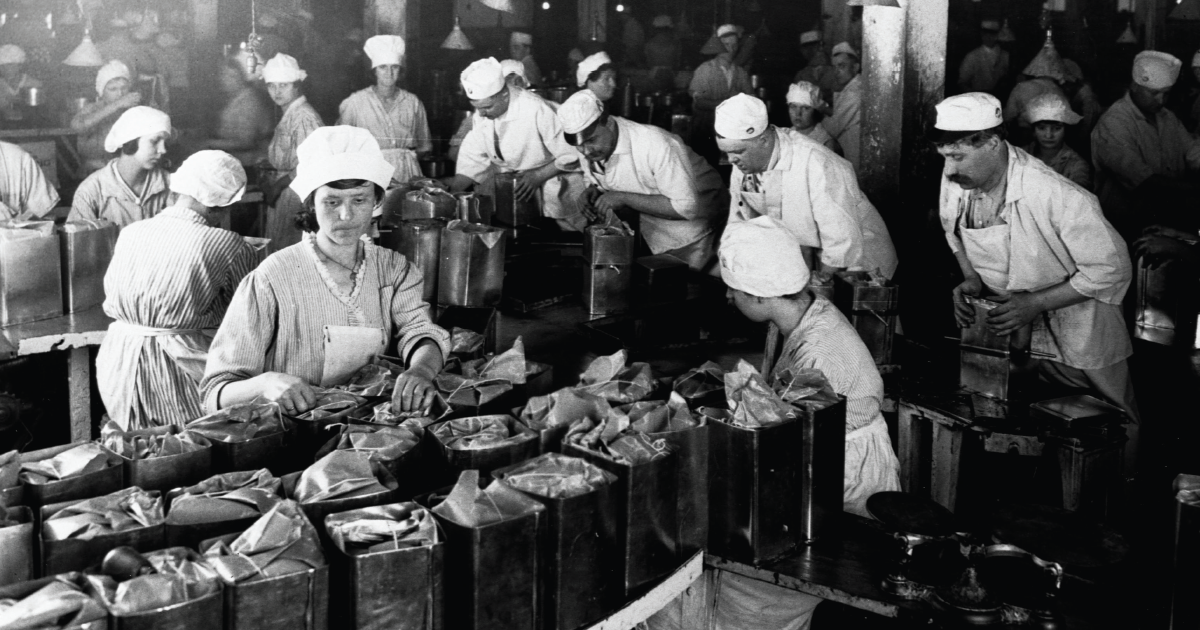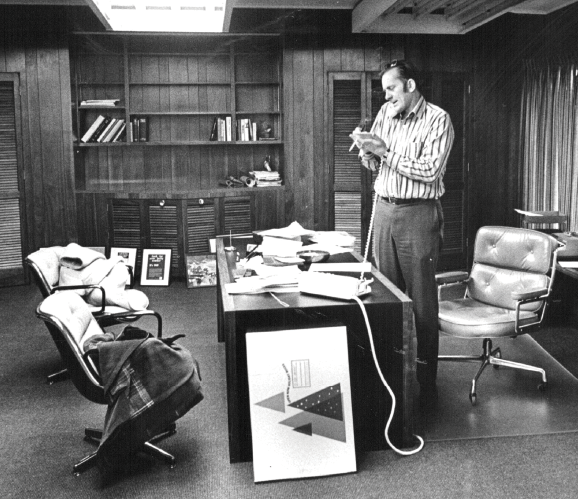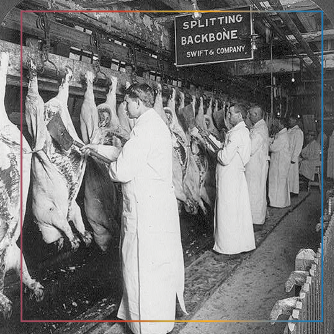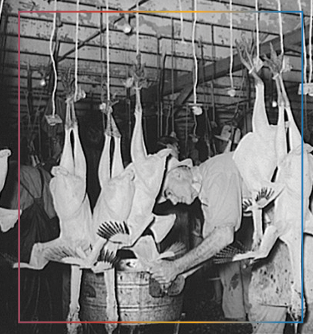By Joel Crews
April 2021
Leaving
Legacies
Looking back at a century of icons, innovations and industry giants


Denver Post/Contributor via Getty Images
Sosland Publishing Company’s coverage of the food industry started out focusing on the grain, flour milling and baking industries for the first 50 years after its founding in 1922. During that same era, the meat-processing industry began a government-mandated transition away from being dominated by a handful of companies that developed an integrated infrastructure that made it almost impossible for outside cattle producers, feedlot operators, livestock transporters or processors to survive unless they were part of what was then, an insurmountable machine. There has always been an important link between the grain industries and commercial livestock production as feed quality and availability determines price, which is passed on to meat processors and the quality, availability and price they could demand for products on the market. A century ago, and still today, the constant has been the meat and poultry processing system’s reliance on grain-based feed to finish and sustain the herds and flocks needed to produce food for a dynamic, growing and migrating population. What has changed and continues evolving are the names in the game today versus 100 years ago.
Few if any of the pioneering companies, brands or descendants of the industry’s legendary leaders of 100 years ago are relevant or involved in today’s industry, evidence of the constant evolution and change that has made meat and poultry processing’s history a long and winding road dotted with plenty of peaks and valleys. Volatility has been a constant challenge for the meat processing industry as it has been for all segments of the food supply chain. Factors ranging from weather to labor issues to regulatory compliance to economic instability to international relations can have profound impacts on the degree of business success or failure any segment might experience.
Since Sosland’s founding, the company has expanded its portfolio of publications and websites to include a wider swath of food and beverage industries, including commercial and retail baking, global grain, meat and poultry, pet food, dairy and the supermarket perimeter. Looking closer at some of the names and companies that were prominent in the meat industry from a century ago sheds light on how the pieces complete the puzzle that is today’s industry.
Gimme’ Five
When considering the iconic meat companies and legendary leaders of a century ago, most historians would agree the five most famous names would include Philip Armour (Armour and Co.), Gustavus Swift (Swift & Co.), Thomas Wilson (Wilson & Co.) Edward Morris (Morris & Co.) and Patrick Cudahy (Cudahy Packing Co.).
Maureen Ogle literally wrote the book on the history of the meat industry. Her book, “In Meat We Trust,” published in 2013, documented how the dominating influence of these and other companies and icons for much of the late 19th century was all but snuffed out in the early 1920s. It was then that a US Federal Trade Commission investigation concluded that the vast majority of all livestock was slaughtered by one of the “Big Five” firms. The companies’ stakeholders were forced to surrender the control they previously had over the transportation infrastructure they relied on to achieve domination of the meat industry for decades by agreeing to sign the FTC’s Meat Packers Consent Decree of 1920. This muted the integrated system of stockyards (established in Chicago initially and later in Kansas City, Texas and westward); cold storage facilities; and the vast network of strategically routed railroads serving the country’s population centers the companies had relied on for many years of success. The decree was a result of an antitrust investigation ordered by then-President Woodrow Wilson. Congress went on with the passage of the Packers and Stockyards Act of 1921, to prevent consolidation and avert the threat posed by a meat monopoly. That power of consolidation was epitomized in the early 1900s by the “Beef Trust,” also known as the National Packing Co. that was formed in 1902 by Armour, Morris and Swift and was broken up about 10 years later. During its reign, the Beef Trust gobbled up scores of stockyards and slaughtering plants in the United States and grew its fleet of refrigerated railcars to thousands in route to controlling the lion’s share of US meat production.
When asked how the “Big Five” forged the path for future meat companies and laid the groundwork for today’s dominant companies and industry leaders, Ogle’s answer is simple.
“They didn’t,” she said.
That was because the consent decree and the Packers and Stockyards Act reshuffled the deck.
“Federal oversight was added to both the stockyard operations and the packing operations,” Ogle said. “All of those old companies really took a serious beating because in effect they had to dismantle a huge part of their corporate infrastructure and kind of start over again.”
The situation was made more challenging because World War I
had just ended and the United States was reeling from almost a half-decade of turmoil resulting from a boomeranging transition from peacetime to war and then back to a focus on domestic civilian life, all between 1914 and 1918.


New Blood
One post-war casualty that resulted was a collapse of agriculture as demand for grain diminished along with Americans’ appetite for beef. The 1920s was also the decade when refrigerated trucks challenged railroad shippers as a means for transporting meat to the growing population bases of the United States. This opened doors of opportunities for many smaller meat companies to break into the meat trade without being hamstrung by the new regulations facing the former industry behemoths.
Additionally, the new packers in the industry also held an advantage over the old guard because they were not bound by labor unions or old ideas that hindered the previous regime. Newcomers to the processing industry boldly forged completely different relationships with cattle feeders and ranchers who would sell directly to them and not be dependent on stockyards.
“Those big packers never again had the lock hold that they once did,” Ogle said. “So, for them, everything was scrambled and by the 1940s, what kept them going was really just the sheer demand (for meat) of another war,” thanks in part to canned meat being used to feed US troops overseas.
But after World War II, a new generation of investors and pioneers, like Warren Monfort and his son Kenneth, created a new model of feeding commercial cattle on a large scale for packers, who would contract directly with Monfort’s company and challenge the Corn Belt in/out feeders. For years, those feeders thrived by specializing in producing grains and when corn prices were low, purchasing and finishing range cattle with corn-heavy diets, cashing in on beef when it was worth more than corn. Monfort’s approach took the seasonality out of feeding and eliminated stockyards from the equation, which hit the Corn Belt hard.
“The stockyards just kind of fell to pieces in the 30s and 40s because there just wasn’t a place for them anymore in the system,” Ogle said.

Feeding Frenzy
Kenneth Monfort would grow his operations to eventually include processing facilities for lamb and beef as well as adding a distribution and transportation company. Monfort was also a pioneer in the industry for first introducing the concept of shipping boxed beef to customers, another departure from the previous era of meat processing. Monfort Beef ultimately became publicly traded and was renamed Monfort of Colorado Inc. ConAgra would go on to acquire Monfort in 1987.
In the post-WWI period feeding operations, like Monfort’s and others, the packing operators were doing business directly with each other, eliminating the once crucial role of the stockyards. Reliance on the railroads was replaced by trucking, which was unregulated for shipping of agricultural products at the time. The former heavyweights that once ruled the industry, no longer were factors and even asked to have the consent decree lifted because they could no longer compete in the new business.
“All of this had a big impact on the Corn Belt and the way people raised livestock and how they calculated the value of grain,” Ogle said.
Most of the legacy companies went through numerous ownership changes in hopes of finding their way back in the industry like the good ol’ days, to no avail.
“They were these big entities that were built for another time and place,” Ogle said. “They were really out of date especially because they had built so much of their infrastructure around railroads and stockyards and by the 1950s, they were just begging to be released from this consent decree.”
Some of the former giants, like Swift and Armour, attempted to survive other ways, including becoming poultry feeders when the broiler industry became a growing segment.
Inside the Box
After the 1950s, newcomers to the meat and poultry processing industry benefitted from the extinction of the top-heavy structure and big names that dominated 40 years earlier. They were not limited by the consent decree and didn’t have to operate under the scrutiny of labor unions, which wielded significant influence in meat plants starting as early as the 1880s and for most of the next 30 years. Add to the equation that well after World War II and especially starting in the 1950s, the US Department of Agriculture was charged with the mission of pushing beef production as much as possible, peaking when cattle production topped 132 million head in 1975. US per-capita consumption of beef would peak the following year.
One example of the next era of meat industry giants was Iowa Beef Processors (IBP), which was founded in 1960 by Andy Anderson, a pork processor, and Currier Holman, a cattle buyer. The duo opened a beef plant in Denison, Iowa, in 1961, with a modest operation that processed about 800 cattle per day. Their philosophy of building plants in rural areas where livestock already were being produced was an attempt at making the system more efficient by cutting transportation costs, securing cheaper, initially non-union labor and processing carcasses into smaller cuts, making boxed beef its focus.
With an industry background working in California and Idaho during the ‘20s and ‘30s, Anderson established IBP using a new and different lens, which didn’t include accommodating labor unions. That first plant was evidence of the new approach and was based on a single-story facility design to be as simple as possible and use as little physical labor as possible without union oversight. Like Monfort, IBP purchased livestock directly from feeders, pushing feedlots further into obsoletism.
“There was no way he was going to build according to the old model,” Ogle said. “He wanted to do exactly the opposite of the old model because that’s the kind of business he’d grown up in, on the West Coast. And so, Denison, Iowa, got this very state of the art and very different kind of operation than Armour and Swift had started.”
IBP’s model of building new-school, non-union processing plants and utilizing an unregulated trucking industry to ship its fresh products paved the way for others.
“Anybody who was a new packer by then, was trying to build a plant that didn’t involve union labor,” Ogle said. “It didn’t mean the union wasn’t going to show up and try to organize the workers, but the unions just didn’t play a part in the mindset of anybody who was thinking about opening a packing plant from say 1930 on, whereas Swift and Armour and Wilson were just stuck with them; they couldn’t get rid of them.”
After several rounds of corporate reorganizations, ownership changes and numerous lawsuits brought by the old guard, they were finally allowed to run some operations without union labor by the 1970s. By then, Swift had built a new beef plant in Grand Island, Neb., that started up in 1965 while investment companies were buying up the fledgling remaining properties of Swift, Armour and Wilson and terminating union contracts as part of many of those deals through the 1970s.
“And of course, by then, they’re still saddled with all those old facilities,” Ogle said, many of which were multi-level operations that were labor intensive and lacking efficiency.
With Anderson’s sole focus on operating packing plants, companies like Swift and Armour were forced to diversify and shift ownership with strategies focusing on a variety of foods, which put them at a disadvantage.
“I think the industry just kind of started over again,” Ogle said. “The business [by then] was so hyper-efficient by comparison. Many people have criticized current packers because their success was predicated on the idea that there would be no union constraints.”
She said what could be considered the “new era” of packers becoming prominent by the middle of the 20th century were located almost exclusively west of the Mississippi River and proudly operated as mavericks compared to the juggernauts that had dominated the industry before them. Monfort led the charge in that regard.
“Those guys saw themselves as breaking all the rules,” Ogle said. “They understood exactly how different their operations were from Swift and Armour. Monfort was pretty blunt about it.”
Part of the success of the newer generation of packing operations was due in part to the emergence of grocery store chains.
“I cannot overstress how important chain grocery stores were to the packing and feeding industry for livestock in the 20th century,” Ogle said. “Andy Anderson, for example wanted to deal with a big chain store with one central buyer.”
Meanwhile, for most of the new plants that didn’t ship across state lines, food safety wasn’t highly scrutinized by USDA inspectors, who were only required to inspect slaughter operations that were doing interstate shipping of products.
Poultry Minded
While pork and beef were king for most of the second half of the 19th century and the first few decades of the 20th century, poultry processing was steadily emerging as a protein competitor. Jesse Jewell, who was credited with making Gainesville, Ga., the “poultry capital of the world,” was a pioneer in the industry for introducing vertical integration to poultry producers. He joined his family’s feed business in 1922 and in 1930 he took the helm, just in time for the Great Depression. Jewell pivoted by supplying economically challenged producer-customers with chicks and the feed needed to raise them at his expense. After the birds were grown to market weight, he bought them back at a price that reflected his feed costs plus a predetermined profit for the effort of those early contract growers.
His family business, J.D. Jewell Inc., expanded its integration efforts in the late 1930s with the addition of a hatchery in 1940 and a processing plant the following year, just in time to reap the benefits from demand spikes related to World War II. Jewell then added a company-owned feed mill and rendering facility in 1954, completing its vertical integration, which served as a business model for future poultry companies. The company, which was known as the world’s largest integrated chicken producer of its time, was recognized for its signature frozen chicken and for being one of the region’s first employers to hire Black workers to staff its plants. Like its red-meat counterparts, J.D. Jewell resisted efforts of the unions to represent its workers in the early 1950s and violent protests to the unions squashed the organization effort. Jesse Jewell was an active poultry industry leader throughout the 1950s and sold the company to an investment group in the early ‘60s.
Ogle said Jewell learned quickly that the road to profitability in the poultry business was not in selling whole birds, but instead selling chicken meat as a value-added item and an ingredient in products such as frozen pot pies.
“Poultry was more of a processed food from the beginning,” she said.
Ogle said chicken, beef and pork peacefully coexisted in the 1950s and ‘60s, largely because steak and pork were abundant and especially after the war, when steak was no longer an aspiration for consumers and became affordable for the masses. In fact, poultry was for a time, viewed as a loss leader used by chain grocery stores to lure bargain shoppers with low-priced chicken to the meat department, where they would be tempted by higher-priced red meat items. Beef was, indeed, king until the 1970s, when rising prices and new questions about the healthiness of red meat began circulating. Soon, fast-food chains began to take notice and started marketing chicken as a healthier option that happened to be less expensive. Between the peak of 1976, per-capita beef consumption bottomed out for the next four years, dropping from 94 lbs per year to 77 lbs per year, the lowest point in a decade. Chicken’s competition didn’t affect the red meat producers until the late ‘70s and ‘80s when production practices like the use of hormones and antibiotics were called into question and consumers looked to poultry as a more wholesome alternative. It was just another in a series of challenges the meat industry has negotiated.
“The beef industry in particular has had kind of a tortured history,” Ogle said.


Leaders with legacies
Some longtime industry leaders from decades past recalled some of the shifting tides in the meat industry. Rosemary Mucklow, the 88-year-old director emeritus of the North American Meat Institute (NAMI), spent most of the second half of the 20th century leading industry trade organizations and lobbying for its stakeholders. When the industry began to make the transition to boxed beef after its introduction in the 1960s, Mucklow recalled the symbolic significance of Miller Packing Co., then based in Oakland, Calif., removing its rail system used to move carcasses. She estimated it was in the 1980s when its owner, Frank deBenedetti realized meat shipments would soon be exclusively made via vacuum-packed primal cuts, making carcass deliveries obsolete. She credits deBenedetti for his vision.
“He took the rails out of Miller Packing before other people were recognizing the change [to vacuum packaging] was coming,” she said.
Mucklow also said the company that pioneered vacuum-packaging technology, Cryovac, the food packaging division of Sealed Air, deserved more credit for the shift to boxed beef.
“Because of Cryovac, we were able to ship vacuum-packaged meat, which has a longer shelf life, and that development drove enormous change in this industry,” Mucklow said.
Barry Carpenter, the retired chief executive officer and president of NAMI who also served as Deputy Secretary of the US Department of Agriculture’s Agricultural Marketing Service, dedicated his 45-plus year career to agriculture.
In the early 1970s, Carpenter supervised meat graders in the Northeast, for processors in Boston, New York and Philadelphia, where railcars and trucks delivered “swinging beef.” However, when boxed beef became the norm in the early ‘80s, graders were cut drastically.
“The whole industry changed,” Carpenter said. “They no longer could come close to competing,” as more cattle were sent to big processing plants. “Since the early ‘80s, I think the percentage of the ‘big four’ was somewhere in the high 70s and it’s probably still there right now, it really hasn’t changed,” he said.

